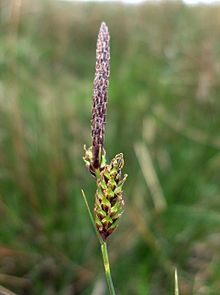Two-veined sedge
| Two-veined sedge | ||||||||||||
|---|---|---|---|---|---|---|---|---|---|---|---|---|

Two-veined sedge ( Carex binervis ), illustration |
||||||||||||
| Systematics | ||||||||||||
|
||||||||||||
| Scientific name | ||||||||||||
| Carex binervis | ||||||||||||
| Sm. |
The two-veined sedge ( Carex binervis ) is a species of the genus Seggen ( Carex ). It is common in Europe and northwestern Africa.
description
The two-veined sedge is a perennial herbaceous plant that reaches heights of 30 to 100, rarely more than 150 centimeters. It grows loose grass with short runners . The stems are triangular and rough on top. The dark green leaves are 3 to 6 mm wide, keeled and about half as long as the stem. Your bulbous leaf sheath wall has a dry-skinned appendage. The basal leaf sheaths are orange-brown.
The two-veined sedge is a variegated sedge. There are one male and two to three female spikelets . The female spikelets are densely flowered, up to 4.5 cm long and stalked, are rather upright, the lowest nodding. The bracts are herbaceous and have long sheaths. The lower bract is much longer than its spikelet, but shorter than the entire inflorescence.
The bracts are egg-shaped with a spike tip and red-brown. They are shorter than the fruit. The stylus has three scars .
The bald fruit is 3 to 3.5 mm long, dark purple in color with two distinct green marginal veins, triangular and narrows abruptly into the beak, which is roughly toothed on the inside and outside.
The number of chromosomes is 2n = 74.
Occurrence
The two-veined sedge is common in Northern Europe and Western Europe. Remarkably, it occurs in Northern Europe ( Norway ) occasionally in locations near the coast that are favored by the Gulf Stream . On the other hand, it is absent in the western Mediterranean area, but it thrives in England , western France , Spain and Portugal . The two-veined sedge is a temperate euoceanic floral element .
Its main distribution area in Central Europe is on the Western European Atlantic coast. In Germany it is rare and occurs sporadically in the southern Odenwald , in the Hunsrück , in the Schneeeifel and in the High Fens. It is also very rare in the subsequent Belgian area.
It grows on dry and damp heaths, which in Central Europe belong to the plant sociological associations Ericion tetralicis and Juncion squarrosi. In Western Europe it is a character species of the order Erico-Ulicetalia. The two-veined sedge needs a mild winter and humid summer climate . It prefers dry sand (heather) as a substrate.
supporting documents
- Rudolf Schubert , Klaus Werner, Hermann Meusel (eds.): Excursion flora for the areas of the GDR and the FRG . Founded by Werner Rothmaler. 13th edition. tape 2 : vascular plants . People and knowledge, Berlin 1987, ISBN 3-06-012539-2 (area).
- Siegmund Seybold (Ed.): Schmeil-Fitschen interactive . CD-ROM, version 1.1. Quelle & Meyer, Wiebelsheim 2002, ISBN 3-494-01327-6 .
Individual evidence
- ↑ a b Erich Oberdorfer : Plant-sociological excursion flora for Germany and neighboring areas . With the collaboration of Angelika Schwabe and Theo Müller. 8th, heavily revised and expanded edition. Eugen Ulmer, Stuttgart (Hohenheim) 2001, ISBN 3-8001-3131-5 , pp. 190 .
- ↑ Rafaël Govaerts (ed.): Carex binervis. In: World Checklist of Selected Plant Families (WCSP) - The Board of Trustees of the Royal Botanic Gardens, Kew . Retrieved October 31, 2016.
- ↑ a b c d e Dietmar Aichele, Heinz-Werner Schwegler: The flowering plants of Central Europe . 2nd Edition. tape 5 : Swan flowers to duckweed plants . Franckh-Kosmos, Stuttgart 2000, ISBN 3-440-08048-X .
Web links
- Two-veined sedge. In: FloraWeb.de.
- Two-veined sedge . In: BiolFlor, the database of biological-ecological characteristics of the flora of Germany.
- Data sheet with identification key and photos from Thomas Meyer: Flora-de: Flora von Deutschland (old name of the website: Flowers in Swabia).
- Photos: [1] , [2] , [3]
